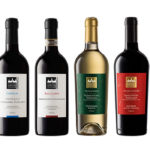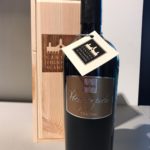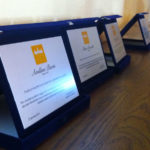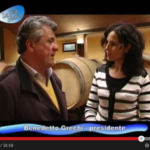 Those who follow us on social networks have already noticed we posted a few articles regarding this project. A couple of weeks ago, we launched an innovative project which implies the use of new technologies and solutions so as to reduce the environmental impact in the vineyard and in the cellar.
Those who follow us on social networks have already noticed we posted a few articles regarding this project. A couple of weeks ago, we launched an innovative project which implies the use of new technologies and solutions so as to reduce the environmental impact in the vineyard and in the cellar.
Who’s taking part?
The project was born thanks to a call for bids by Regione Toscana. We applied as group leaders, with the involvement of other local wineries: Fattoria Mantellassi, Fratelli Bruni and Azienda Montauto. On top of them, there’s also the support of Consorzio di Tutela del Morellino di Scansano Docg. The project, curated by Daniele Schirru, a very talented agronomist who over the years specialised in project design, includes the collaboration of two very prominent academic institutions: Università della Tuscia and Scuola Superiore Sant’Anna di Pisa under the scientific direction of professor Fabio Mencarelli. In other words, this time Vignaioli del Morellino di Scansano who even by themselves comprise a nice team of over 150 members, have enlarged their team. After all, as Benedetto Grechi, president of the cooperative, pointed out, “it is only as a team that we can approach the market, these days”. As Vignaioli, teamwork is part of our DNA, just like working for our territory. It was, in conclusion, the most natural step to take.
What does this innovative project for the vineyard consist of?
The project is starting these very weeks and will last two years. During this period the technologies studied by Prof. Fabio Mencarelli and his team of researchers will be applied. The innovations can be divided into three basic groups:
- ozone, in the vineyard and in the cellar
- drones
- sensors and Arduino (if you don’t know what this is, don’t worry, we explain it below)
 How ozone works in the vineyard and cellar
How ozone works in the vineyard and cellar
Ozone is a gas whose formula is O3: it is formed by three atoms of oxygen. Its interest, in our case, is based on the fact it can serve to disinfect and sanitise the leaves. It also induces the plants to become more resistant. The idea is to treat plants and grapes with ozone, so as to keep them healthy without chemicals. In this way, as ozone leaves no residuals, it will be possible to “treat” the plants without damaging the environment. Quite the contrary. Once used, ozone becomes oxygen. Moreover, as ozone doesn’t leave residuals, it will be possible to treat the vineyard even close to the harvest, with no risks for customers.
Attention, though: as ozone is not a “stable” gas, it is not directly diffused on the plants but the prototype currently being used includes the use of ozoned water. Different tools are currently under study.
At the same time, ozone can be used in the cellar to reduce or eliminate the use of sulphites and to disinfect and sanitise rooms and tools used for vinification and maturation. Once again, the fact ozone leaves no residuals will allow to easily recover the water used in these phases. Even in this case, therefore, the management of resources will be optimal.
Using drones in the vineyard
Over the past few years, an interesting branch of agricultural sciences is being developed which uses technological instruments such as drones in the fields. Through drones it is possible to monitor the vineyard at much lower costs than in the past. Indeed every vineyard differs from the other in terms of soil, exposure to the sun, location. In fact, sometimes there can be differences even within the same vineyard: from one line to the other the type of soil can change, or the level of humidity, just to name two elements.
The drone used in this project is capable of mapping one hectare of vineyard in just 6 minutes. Through a hyper-spectral camera and a 3D scanner it takes a picture of the vineyard, plant by plant, acquiring info in terms of vigour, hydric stress and other physiological data. The maps created by the drone are then assembled so as to form a mosaic with the total of the vineyard, thanks to the placing of ground control points.
Sensors and Arduino boards help monitoring the vineyard
On top of the drone, we’ll use other low cost microsensors linked to an Arduino board. Arduino is a board which, connected to sensors and other tools, allows to create prototypes for hobby or professional use, as in our case. It was invented in Italy and is now popular all over the world. It is named after a café in Ivrea where the founders of Arduino used to meet to discuss this project. For instance, if we use it at home, it can allow us to create a system through which you can automatically turn on the lights at dusk. In our case, instead, the Arduino boards are connected to microsensors and will be used to create micro-climatic stations in the vineyard. These will collect all the data on a SD memory card (like the ones used for cameras) and will then communicate them via Bluetooth to the workers, even at a distance. It will also be possible to collect data through a NIR spectrometre connected to a computer.
All these data, collected through these Internet of Things devices, will make it possible to build a provision map, which will include all the indications on how to set the tractor so as to intervene only when and where necessary.
Minimal environmental impact, maximum economic sustainability
Environmental sustainability is essential. It allows us to ensure that future generations will have a future that is as healthy as possible. Yet paying attention to the environment, in order to be a long-term strategy, must also be economically sustainable. This is why the innovations we’re experimenting these days in the vineyard and which we hope will be of use to other wineries too in the future are important. By reducing the use of chemicals, helping plants only where and when it is necessary, we reduce the environmental impact and reduce costs too. In other words, paying attention to the environment means being more efficient too. This finally is an advantage for the consumer, who will be able to drink a good, environmentally friendly wine at accessible prices.
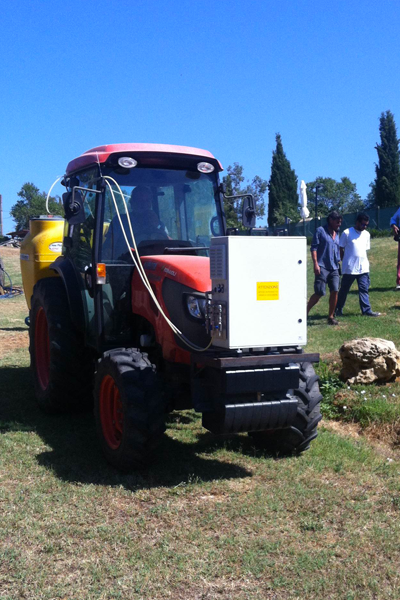 How ozone works in the vineyard and cellar
How ozone works in the vineyard and cellar